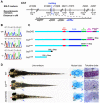Sec24D-dependent transport of extracellular matrix proteins is required for zebrafish skeletal morphogenesis
- PMID: 20442775
- PMCID: PMC2860987
- DOI: 10.1371/journal.pone.0010367
Sec24D-dependent transport of extracellular matrix proteins is required for zebrafish skeletal morphogenesis
Abstract
Protein transport from endoplasmic reticulum (ER) to Golgi is primarily conducted by coated vesicular carriers such as COPII. Here, we describe zebrafish bulldog mutations that disrupt the function of the cargo adaptor Sec24D, an integral component of the COPII complex. We show that Sec24D is essential for secretion of cartilage matrix proteins, whereas the preceding development of craniofacial primordia and pre-chondrogenic condensations does not depend on this isoform. Bulldog chondrocytes fail to secrete type II collagen and matrilin to extracellular matrix (ECM), but membrane bound receptor beta1-Integrin and Cadherins appear to leave ER in Sec24D-independent fashion. Consequently, Sec24D-deficient cells accumulate proteins in the distended ER, although a subset of ER compartments and Golgi complexes as visualized by electron microscopy and NBD C(6)-ceramide staining appear functional. Consistent with the backlog of proteins in the ER, chondrocytes activate the ER stress response machinery and significantly upregulate BiP transcription. Failure of ECM secretion hinders chondroblast intercalations thus resulting in small and malformed cartilages and severe craniofacial dysmorphology. This defect is specific to Sec24D mutants since knockdown of Sec24C, a close paralog of Sec24D, does not result in craniofacial cartilage dysmorphology. However, craniofacial development in double Sec24C/Sec24D-deficient animals is arrested earlier than in bulldog/sec24d, suggesting that Sec24C can compensate for loss of Sec24D at initial stages of chondrogenesis, but Sec24D is indispensable for chondrocyte maturation. Our study presents the first developmental perspective on Sec24D function and establishes Sec24D as a strong candidate for cartilage maintenance diseases and craniofacial birth defects.
Conflict of interest statement
Figures









References
-
- Barlowe C, Orci L, Yeung T, Hosobuchi M, Hamamoto S, et al. COPII: a membrane coat formed by Sec proteins that drive vesicle budding from the endoplasmic reticulum. Cell. 1994;77:895–907. - PubMed
-
- Bonifacino JS, Glick BS. The mechanisms of vesicle budding and fusion. Cell. 2004;116:153–166. - PubMed
-
- Fromme JC, Orci L, Schekman R. Coordination of COPII vesicle trafficking by Sec23. Trends Cell Biol. 2008;18:330–336. - PubMed
-
- Boyadjiev SA, Fromme JC, Ben J, Chong SS, Nauta C, et al. Cranio-lenticulo-sutural dysplasia is caused by a SEC23A mutation leading to abnormal endoplasmic-reticulum-to-Golgi trafficking. Nat Genet. 2006;38:1192–1197. - PubMed
Publication types
MeSH terms
Substances
Associated data
- Actions
Grants and funding
LinkOut - more resources
Full Text Sources
Molecular Biology Databases

